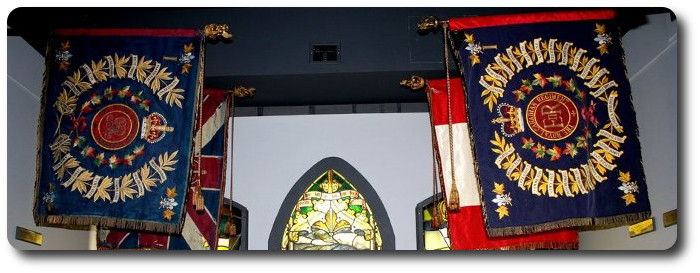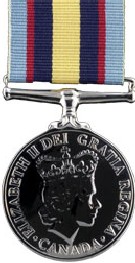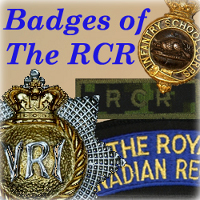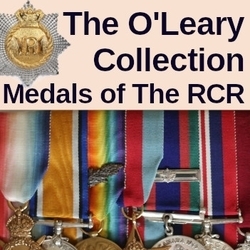
Researching The Royal Canadian Regiment
"Mike" Company In The Persian Gulf
(3rd Battalion, The Royal Canadian Regiment's Support of Operation Scimitar)

The Gulf and Kuwait Medal recognizes the participation of CF members deployed or in direct support of the operations against Iraq during the Gulf war. The medal is awarded to those employed during the build up of troops before the beginning of hostilities, and a bar is awarded for those deployed during the actual war.
Capt Greg Miller
Pro Patria, Issue No. 70, April 1991
The Canadian decision to support the United Nations embargo against Iraq firstly with a naval task force and then subsequently with a fighter squadron, set into motion a series of gears that had not been exercised since the end of the Korean War. Initially the Canadian Air Task Group Middle East (CATGME) was prepared to rely on four military policemen and the host nation's in-place forces for security; however, after a more thorough threat assessment the Air Force requested the warning off of a security force much larger than that originally considered. Tasked to provide a 100 man force on standby to provide airfield security, 3 RCR's Commanding Officer LCol J. Ivan Fenton selected one of his four rifle companies to fill the task. The CO chose 'M' Company to form the framework of the force and augmented it with 21 other members of the Battalion, including a radio operator, a cook, a medic and a Fire Control Systems technician. This company, under the command of Major Mike Blanchette, assembled on the evening of 19 September 1990 in support of what had become known as Op SCIMITAR.
With the Battalion departing for the annual 4CMB fall training concentration, the true flexibility of the infantry became apparent. Mike Company quickly locked their M113 armoured personnel carriers and drew their jungle boots, swinging easily into the role of a dismounted rifle company. The OC initiated an intensive training schedule coordinated by the Company Second-in-Command, Captain Greg Miller and the Company Sergeant Major, Master Warrant Officer George Leach. During the next ten days the company covered weapons refresher on all support weapons, grouping and zeroing of all personal weapons, challenging procedures, search techniques, a myriad of intelligence briefings, environment lectures and desert hygiene briefings.
Without a defined or confirmed task logistic preparations were difficult. Company Quarter Master Sergeant, Warrant Officer John Tarrant, spent this two week wait gathering everything he and the Technical Quarter Master Sergeant, Warrant Officer Bob Cotton, could think of to cover all eventualities. Fifty-three flex pallets later the CQ proclaimed that he was ready but the Air Force had not yet found a base to call their "desert home".
Time dragged on and the Company settled back into a semi-normal routine; there was even talk of starting the tracks, ordering low beds and heading for Hohenfels, when on the 28th of September the OC finally departed with the CATGME recce party. At that time the mention of a rifle company joining the task force was still largely unknown. The Air Force command element was still uncertain of exact requirements and had not yet formally requested security support. Well as the old saying goes: "time spent on recce is seldom wasted"; Maj Blanchette certainly put his two and one half days in Qatar to good use; upon his return from this "desert home" he brought with him a vastly converted Air Force recce party and within 8 hours of his return to CFE, CDS approval for the commitment of a 100 man "security company" had been received.
At this point a description of our destination would be appropriate. The state of Qatar is a thimble like peninsula that juts out into the Persian Gulf approximately half way along the Eastern side of the Arabian Peninsula. It's population is about 400,000 of which only l00,000 are native Qataris, the other 300,000 are Palestinian refugees, Indian or Pakistani migrant workers and a small community of Sudanese and Yemenese. The people are traditional Moslem and of course the state is "dry". The terrain is generally flat and characterized as a rock desert, however in the central region there is a small classic dune desert. There are three major cities of which the capital, Doha, is home to 75 percent of the population, and for all you golf fans there is one nine hole sand golf course as Lt (now Capt) Bill Hoskins can attest. The airfield which CATGME selected has a runway which stretches 15,000 feet and is reported to be the second longest airstrip in the world. It is divided into two sectors, a busy international terminal and the home of the Qatari Emirate Air Force. The Canadian deployment in Qatar is characterized by the now familiar Canada Dry 1 (CD1) and Canada Dry 2 (CD2) camps. In addition there are two further areas of Canadian activity, the military aircraft ramp and the Quick Reaction area. These four areas were allocated as three platoon tasks.
CDl approximately 3.5 km from the airfield, became the home of the Canadian Support Unit Qatar (CSU(Q)) and tasked with its security was Lt (now Capt) Shawn Benoit and 2 PI, with Warrant Officer Len Kohn as his platoon Warrant Officer. CD2, the airfield accommodation site, a 100 m x 300 m Canadian constructed compound surrounded by a Type 2 concertina fence became the turf of 1 PI commanded by Lt Bill Hoskins with Warrant Officer Perry Fisher as his platoon Warrant Officer. The remaining two sectors became the domain of 3 PI under Lt Rob Boyd and platoon Warrant Officer, Sgt BJ McKay.
The Company main body arrived in Qatar on 5 October and with the traditional spirit of hard work which dwells in all members of The RCR, the soldiers of Mike Company attacked the task at hand: "Defending Canadian personnel, aircraft and combat supplies from ground attack". This, in the state of Qatar was no simple matter. Traditional defensive thinking and methods of construction went quickly out the window. Used to digging in, the Company found this impossible for two reasons; one, the ground underneath the first six inches of powdery dust was as solid as concrete and two, permission to even attempt to dig in the most tactically sound areas was forbidden, so building above ground bunkers became the order of the day. Of necessity the OC became a skilled diplomat as each position had to be personally approved by the Qatari Base Commander. Maj Blanchette carefully negotiated for the best solution possible and gained the Qatari's blessing for each and every position allowing construction to carry on. In all 100,000 sandbags, 1000 feet of 4" x 4" beams and 600 pieces of corrugated metal were used to construct the fourteen positions. The most impressive position was the bunker at the entrance to CD1, a huge machine gun position that took an estimated 3,000 sandbags to construct. A total of ten weeks were required to construct these positions. The time required was extensive because of the many delays in obtaining defensive stores. Bunkers stood for three weeks awaiting materials required for overhead protection. Even sand was a problem and twice weekly CQ Tarrant led his convoy of Qatari dump trucks through the base delivering the necessary sand to fill the sandbags.
To break the monotony of the work cycle and to provide the necessary test firing of weapons the Company Operations Officer, Capt Glenn Sylvester, was tasked to obtain firing time on the local ranges. The Qatari Army was very helpful and soon Mike Company was off across the desert in search of ranges. It was arranged to fire .50 cal HMG, C-6 and 60 mm mortars at a Qatari field firing range. Familiar with restrictive European ranges the company found the range had only two restrictions, fire towards the North West (area of the Persian Gulf) and the requirement to clear the range of all camels before firing. Three trips were made to this range allowing each platoon commander to run extensive machine-gun ranges. In addition to support weapons the company fired their personal weapons three times to maintain proficiency. These practices were conducted on an innovative Qatari range beside CD2. This range incorporated a metal backstop which deflected the spent rounds down into a catch which enabled the collection of the slugs afterwards. Our Air Force brethren did not appreciate the use of this range as the distinctive crack and thump of small arms fire deprived them of their sleep not to mention their sense of well being.
Delays in material availability and ingenious shift scheduling allowed for some recreation to occur. Numerous invitations were extended to Canadians in Qatar and members of the Company managed to attend some interesting events. Our Company Pipers, Cpl Chris Norquay, Cpl Stephen McA1lister and Cpl Stuart MacDonald performed at the annual Doha St Andrew's Day dinner and soon were the hottest item on the Doha party circuit. MCpl Darren Moxam had the opportunity to ride on (and fall off of) a million dollar racing camel. There was even an opportunity for a family reunion; Pte Paul Grace had an opportunity to spend an evening with his brother LS Adrien Grace on HMCS Athabaskan while the destroyer was in Doha. Perhaps the greatest recreation was the shopping, led by our kings of capitalism, CSM Leach and Sgt Wayne Snelgrove; truckloads of hope chests, rugs and clothing were brought back.
Life in Qatar was not without its dangers. Twice the missile warning system sprang to life and sent us scurrying for our shelters only to allow us to reappear moments later to false alarms. The greatest natural threat was not the dreaded scorpion but the periodic sandblasting that was received during sandstorms that reminded one of whiteouts in Shilo.
Tour length for the security company in Qatar has been set at 14 weeks, however the initial rotation was designed to have the entire CATGME rotated by Christmas. To this end Mike Company was relieved by C Company 1R22er between 19 and 23 Dec 90. Aircraft serviceability threw this schedule out of sync and the last of Mike Company left Qatar at 1100 on 24 Dec arriving on the North Marg at CFF Baden-Soellingen like fifty-nine Santa Clauses at 0100 hours on 25 Dec 90.
We must extend our heartfelt thanks to all those members of the Regimental Family who expressed their support; the countless numbers of letters, cards and well wishing received was greatly appreciated. As one might expect on this type of operation, there was no individual who was solely responsible for the successful completion of Mike Company's mission in Qatar. The success of our endeavour lies in the performance of our soldiers. Their quiet professionalism and willingness to get the job done to the best of their abilities in a difficult situation has once again brought credit to The Regiment.


